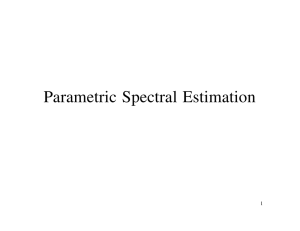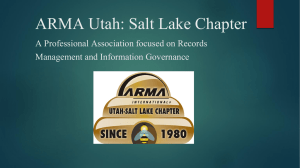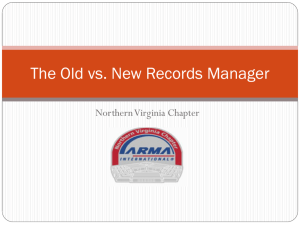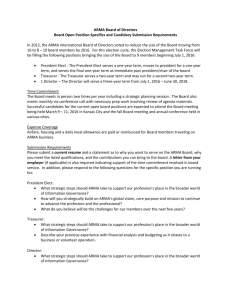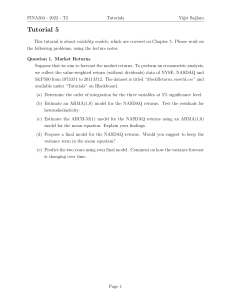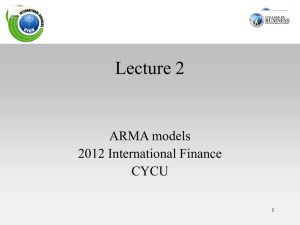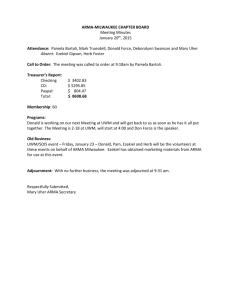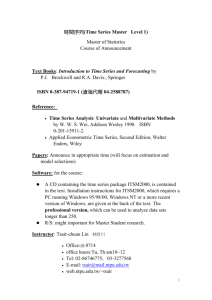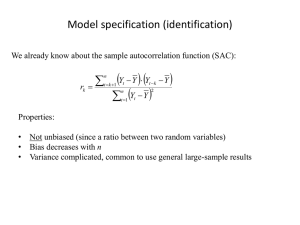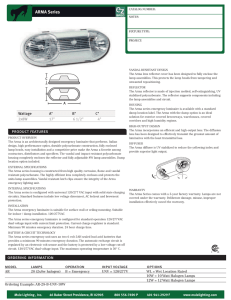Records Management 8th Edition
advertisement
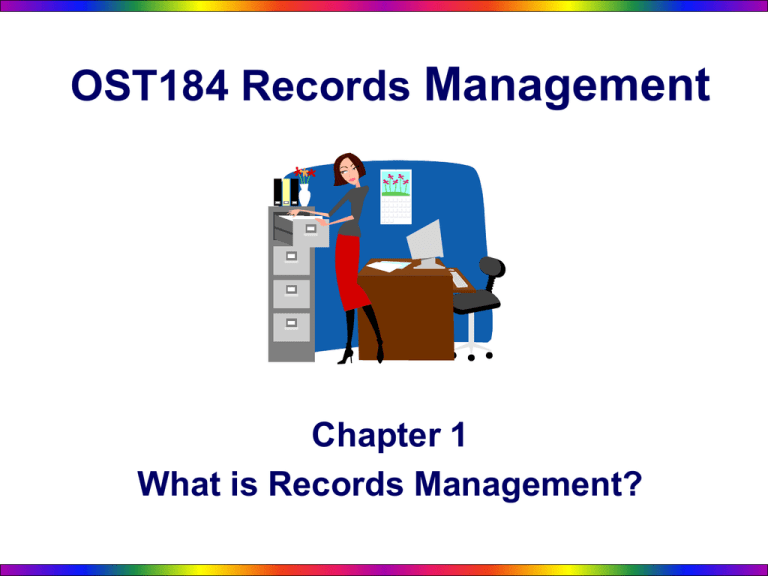
OST184 Records Management Chapter 1 What is Records Management? What Are Records? According to ARMA International (Association of Records Managers and Administrators, Inc.) - an association for information managements professionals) A record is stored information, regardless of media or characteristics, made or received by an organization that is evidence of its operations and has value requiring its retention for a specific period of time. According to ISO 15489 (International Organization for Standardization) – worldwide federation of national standards organizations) Information created, received, and maintained as evidence and information by an organization or person, in pursuance of legal obligations or in the transaction of business. What Is Records Management? • Management is the process of using an organization’s resources to achieve specific goals through the functions of planning, organizing, leading, and controlling. • Records management is the systematic control of all records from their creation (or receipt) through their processing, distribution, organization, storage, and retrieval, to their ultimate disposition. • Records management is also known as RIM (Records and Information Management). Records and information management involves organizing information for retrieval. Why Is Records Management Important? • The proliferation of information, legislation, and storage of information all contribute to a growing problem for individuals, organization, institutions, businesses, and countries. • How is information managed to meet the needs of the people who need it? • With so much information produced daily, how is specific information accessed when needed? • Business must have up-to-date information: − in the right form. − at the right time. − in the right place to make management decisions. What Are the Legal Considerations for Records Management? • As companies rely increasingly on information stored on a variety of media, records managers must be certain that their companies’ recordkeeping systems are legally acceptable to governmental agencies and courts of law. • Compliance issues are a concern to many organizations. • Records management professionals are working together in organizations such as ARMA International and AIIM to optimize the effectiveness of records and information management to their organizations. Legislation balances and protects: − An individual's right to privacy. − Public’s access to information. − Quest for national security. See page 17 in book for legislation related to records management. How Are Records Classified? By type of Use By Place of Use By Value • A transaction • External records document is a are created for record used in use outside an an organization. organization’s • Internal records day-to-day contain operations. information • A reference needed to document operate an contains organization. information needed to carry on operations of a firm over long periods of time. • Vital records usually not replaceable; highly protected. • Important records usually replaceable but at great cost; highly protected. • Useful records usually replaceable at slight cost; medium degree of protection. • Nonessential records have no value after initial use; lowest degree of protection. Why Are Records Used? • • • Records serve as the memory of a business. They document the information needed for complying with regulations and the transactions of an organization. Records are retained because they have one of four values: − Administrative: Helps employees perform office operations. (handbooks, policy/procedure handbooks) − Fiscal: Used to document operating funds and other financial processes. (tax returns, purchase/sales orders) − Legal: Provide evidence of business transactions. (contracts, deeds, articles of incorporation) − Historical: Documents the organization’s operations and major shifts of direction over the years. (minutes of meetings, corporate charter, public relations documents) Trends in Records and Information Management 1. Electronic records - stores a record on electronic media. 2. Electronic mail - documents managed across networks. 3. Document imaging - images of paper scanned in electronic format. 4. Internet (WWW) - worldwide hypermedia system 5. E-commerce - electronic method to conduct business communications/transactions over networks and computers. 6. EFT (Electronic Fund Transfer) - electronic payments and collections; paycheck deposited automatically. 7. EDI (Electronic Data Interchange) - communication between two companies through computers. 8. ECM (Enterprise Content Management) - technologies, tools, and methods used to capture, manage, store, preserve, and deliver content/information across organization What Are the Records Management Functions? • Planning - establishing goals and the methods required to achieve them • Organizing - arranging tasks, people, and other resources needed to meet the goals • Leading - managerial behavior that supports the achievement of goals • Controlling - measuring how well the goals have been met The record life cycle is the life span of a record as expressed in the five phases. Life Cycle of Records Programs for Managing Records • Well-defined goals understood by all workers. • Simple, sound organizational plan. • Efficient procedures for managing each of the five stages in the record life cycle. • Well-trained staff. Sometimes the program is centralized, and in other cases, decentralized. Centralized: records are physically located and controlled in one area Decentralized: records are physically located in the departments where they are created and used. Problems in Records Systems A records system is a group of interrelated resources – people, equipment, and supplies, space, procedures, and information – acting together according to a plan to accomplish the goals of the program. Problems: − Management − Human problems − Inefficient filing procedures − Poor use of equipment − Inefficient use of space − Excessive records costs Careers in Records Management • Opportunities exists in every type and size of office. • Opportunities also exists in the marketing of records supplies and storage equipment. • In major corporations, there are levels: (1) Managerial Level; (2) Supervisory Level; and (3) Operating Level ARMA International • • Association of Records Managers and Administrators, Inc. An important professional group for records and information managers. It − Improves educational programs in schools and industry. − Provides on-the-job knowledge about records and information management. − Provides information on careers and job banks. − Provides online learning opportunities. ARMA web site address http://www.arma.org

